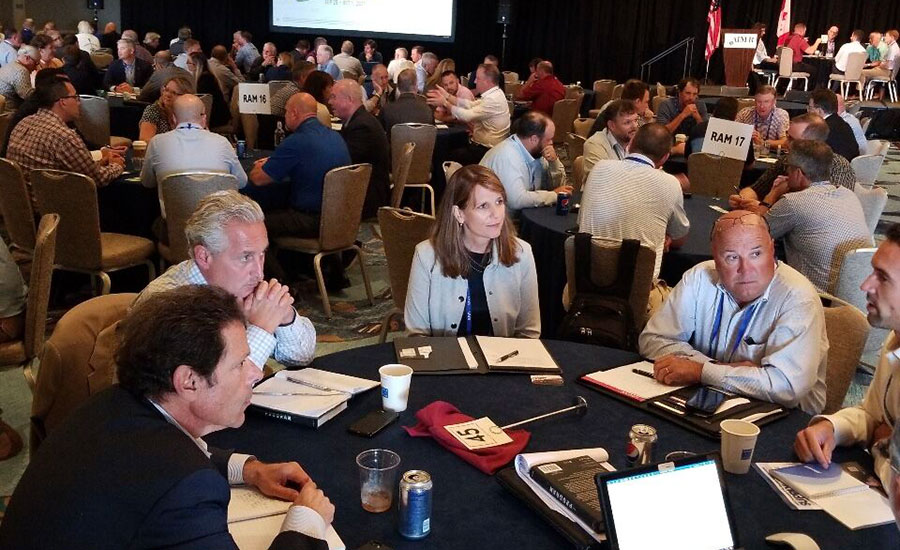The days of manufacturers’ reps hitting the pavement making sales call after sales call are long gone. Today, reps are often taking on reporting, marketing, training, data analytics and through times of disruption, damage control.
During the annual Supply House Times-AIM/R roundtable discussion, which took place in-person in San Diego, California during the association’s annual conference, reps from across the country agreed that the role of the manufacturers’ rep is expanding more rapidly than ever before — as is the opportunity for growth and new business.
Dean Parker CPMR, president of Minneapolis, Minnesota-based firm Michel Sales Co. explains reps are responsible for more tasks than ever before.
“We’re taking on the marketing roles, data analytics and reporting,” he says. “Years ago, a lot of the product marketing material was provided for us, now we’re creating it ourselves.”
Hendersonville, Tennessee-based A6 Sales President John Altepeter agrees, emphasizing the data analytics role reps are now taking on. “We're shifting more to a business analyst with our distributors than just a shoulder-to-shoulder selling mechanism,” he says. “Our distributor customers are wanting information given to them from a financial or operational benefit standpoint. A lot of our role is becoming more technical and analytical overall.”
All participants agree that reps are expected to provide much more information than ever before.
“The industry as a whole is requiring more information be readily available — the reporting reps are doing now for manufacturers is one example,” says Ray Gonzalez, CPMR, sales manager for Boca Raton, Florida-based Carr Co. “Additionally, we are striving to be an extension of the distributor salesforce.”
Gonzalez says technology and the enhanced level of connection the industry is capable of today has played a huge role in the expansion of the rep role.
Ian Price, vice president sales and marketing for Commerce, California-based Carrhill Co. says rep agencies have essentially become a critical resource for all levels of manufacturer and distributor businesses. “Our sales role has rapidly evolved over the past year and a half,” he says. “We’ve become both a physical and digital resource to help train and extend the staff of the distributor and end user, and that training flows into their inside and outsides sales departments and customer service.”
The reps agree that these increasing expectations and roles make for a stronger partnership overall.
“This whole paradigm has pushed us to become more efficient and more capable,” Price says. “And it certainly places more load on our staff as reps, but it’s given us the opportunity to become an even more valuable partner than before.”

More roles, more people
With the many hats reps are wearing today, it’s become a necessity for agencies to hire new talent for roles they may not have had internally before.
“We’re having to bring on marketing people, web designers and analytics experts,” Parker points out. “The factories are watching what we’re doing digitally. At Michel Sales we’ve got a younger woman that handles data analytics, data entry and social media and she’s been extremely helpful in taking on these new roles.”
In the incredibly tight labor market the country is experiencing, it isn’t easy for reps to find talent to fill these roles. According to Price, hiring qualified family and friends has proven successful for Carrill Co.
“This is a very family-oriented type of business model we’re in. Both past and future leadership will be family members or extended family and friends, so we're doubling down on that to identify who within our organization to discuss opportunities with,” he says. “And not necessarily just within our organization, but who outside industry do we know that don't have a professional path already planned out. We engage with them and say, ‘Hey, you have to let me tell you a little bit about the industry and a look inside the business.’”
Parker adds that it is difficult to find the right people for the many different roles an agency might be looking to hire. “We’re fortunate in our industry that we’re able to offer competitive wages,” he points out. “When someone comes along that isn’t a fit, you can tell within the first couple of weeks, and when you find that hard-working, talented person, you want to hold onto them tight.”
Gonzalez notes that when hiring and training the next generation, there is a balance that needs to happen. “It’s important for the youth coming in to realize that while they bring a new skillset and talent to the team that we need, there are decades of experience within the company that they need to learn from,” he says. “If they’re willing to latch onto someone and learn, that young person becomes even more valuable because they have this new knowledge plus the talent they had coming in.”
Interconnected sales strategy
As new tasks are added to their plates, reps are adjusting their sales strategies.
“We're wired to be salespeople. We're wired to help create demand for product. We're wired to convert customers over to our products,” Gonzalez says. “But now, we’ve become analytics people, so we have to find a way to make that work and blend that into our agency because at the end of the day, we need to sell the product and convert customers.”
Altepeter points out that insides sales teams have become even more connected than they were before the pandemic. “I'm seeing a rise in the virtual relationship from inside-to-inside people,” he says. “It’s always been a strong relationship, but when we lacked face-to-face time on the outside sales side, the inside teams really stepped up and made sure everyone was connected; they were built for that type of virtual connection role while the outside sales teams had to adjust.”
Parker adds that as customer service and response time has become more vital, the inside sales teams have done a great job at extending their roles to take on customer service requests.
Gonzalez agrees, saying the inside teams have played a huge role in the level of communication needed in business today. “They've done a great job of being that vehicle of communication back to our manufacturer, even more so than normal,” he says. “They have longstanding connections with the people who can move things around and help fill an order. They talk to them on a regular basis, so it's important for us to make sure the inside folks have the tools needed to get the job done.”
Strategies for a disrupted market
According to Altepeter, as distributors are facing issues retaining enough inventory, the rep role has shifted from helping make inventory turn to helping distributors get inventory.
Not surprisingly, communication is the common denominator when it comes to working through supply chain disruption.
“There’s more communication happening from all sides right now,” Parker says. “It actually gets redundant for us because we’re explaining things to the purchasing agent, then the director of purchasing and then to the president of the company; making sure the information gets on everyone’s radar.”
Gonzalez agrees, saying reps now communicate with people on all levels of the project. “We're communicating with all of the channels, not just the wholesaler. We're relaying information back through the contractor and at the builder level, reiterating when needed to make sure everyone knows what’s going on.”
Parker adds that although everyone understands the disruption or bad news is not the reps’ fault, it does get old being the one to deliver unfortunate updates. “We must take the good with the bad,” he says.
Gonzalez summarizes the disruption well, saying it’s unprecedented for everyone involved. “No matter how long you've been in the business, we are all seeing things that are unprecedented. It doesn't matter how many decades you've been in this. We all think we've seen a lot of things, but this has been something we just couldn’t have seen coming.”
“The future of our piece of the channel will definitely come from adapting and diversifying.”
— John Altepeter
Despite the disruption facing the industry, Price finds a way to identify the positives. “I like to think that there's some really positive things that have happened, too. It commands the question of who your alliances are in your supply chain,” he says. “Historically, just-in-time inventory worked and cash management was king. Well, at this point, though cash is always king, inventory is right up there with it, because standing inventory now is cash — you have product to sell or you don't. And this creates growth opportunities and partnerships.”
Price adds that Carrhill Co. is focused on being a valuable ally with its distributors, offering available product solutions different than what many have been used to for years; when that go-to product is unavailable, the company offers some alternate acceptable solutions they may not have thought of before.
Under current restraints, some manufacturers are choosing to focus on loyal, existing customers rather than finding new business, reps have the opportunity to explore and provide new business avenues. “As we move forward, I believe some distributors may reconsider single alignment with just one manufacturer,” Price says. “This will encourage new conversations with our trade partners we may not have done business with before, creating new value-add relationships, available inventory capital and shared growth opportunities.”
When it comes to helping distributors be as proactive as possible while working through disruption, Altepeter says being a one-stop-shop for information has helped tremendously. “We’re corralling all of our line information into a single source,” he says. “We put out an updated document daily with all of our inventory information, factory increase percentages and lead times. Distributors have really appreciated this.”

The reps agree that for the most part, customers are understanding, and the industry is still all about relationships.
“Thankfully, it’s still about relationships,” Gonzalez says. “And it’s on us to make sure it stays that way. We have to be relevant. We have to keep ourselves fresh by hiring newer people and people that get it. Just continuing to keep up with the changes.”
“The positive side is that there’s still business — many of us had really great years last year,” Gonzalez adds.
Relevancy is the road to success
As reps work to remain relevant in a growing digital, virtual marketplace, the participants say it’s all about being purposeful with your message.
“We’re working to increase and enhance the relevance of whatever we are pushing out digitally,” Altepeter says. “When face-to-face wasn’t an option, emails increased and many people missed the message if they missed your emails.
Not exhausting our customers is key in making sure they find relevance in our digital message. We’re looking at open rates and creating short messages with a clear call-to-action.”
Price notes that brand awareness has been a great focus in order to remain relevant. “In some cases, manufacturers have been rather disconnected from end-users,” he says. “So we’re encouraging them to invest in us as a local market extension of their business, providing and supporting high performance CRMs, data sets, training and connectivity to our distributor partners and end users supporting our increasingly virtual and contact-free marketplace.”
Price adds that with the increased amount of digital communication came the ability to be more efficient. “We’re working to build a community and have relationships and access to the end-user,” he says. “At the end of the day, time is money, so however we can most quickly and accurately flow information through the chain is best; whether it’s texts, phone calls or emails.”
When discussing the continuous battle with online and big box retail, Gonzalez says he’s impressed with the services distributors are offering.
“The wholesalers have done a great job rising to the challenge of customer expectations that Amazon has created,” he says. “They’ve got GPS tracking, iPads and photos of when inventory gets loaded on and off the truck so customers are kept up-to-date.”
With all of the market changes, new expectations and challenges ahead, reps agree that new business opportunities are just as plentiful.
“The future of our piece of the channel will definitely come from adapting and diversifying,” Altepeter says. “Having a service department, training department and training centers — the things that our manufacturers and distributors can’t regionalize — are things we as reps can do.
“One of the biggest things I’ve seen help our distributors is reminding them of the tremendous value they bring,” Altepeter continues. “They can get lost in the day-to-day of things, but we remind them of the value they bring that big box can’t offer; just take the time to pull them aside and say ‘What you’re doing is good; you’re adding value and that warrants a premium price.’”





